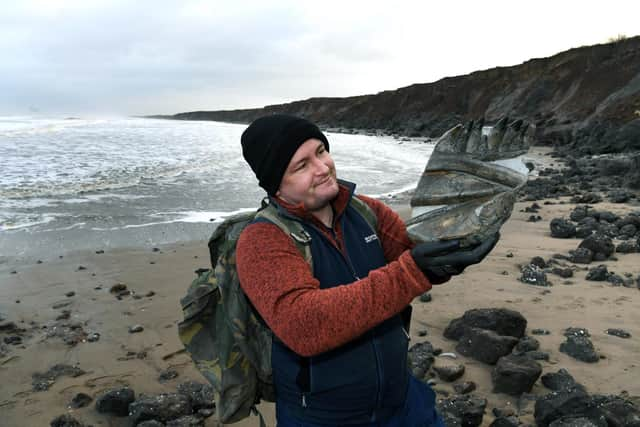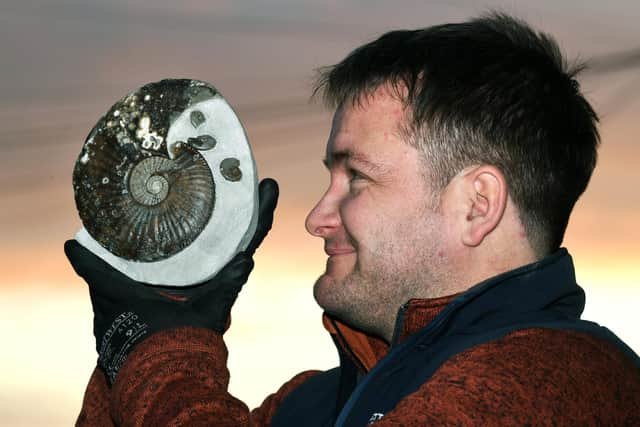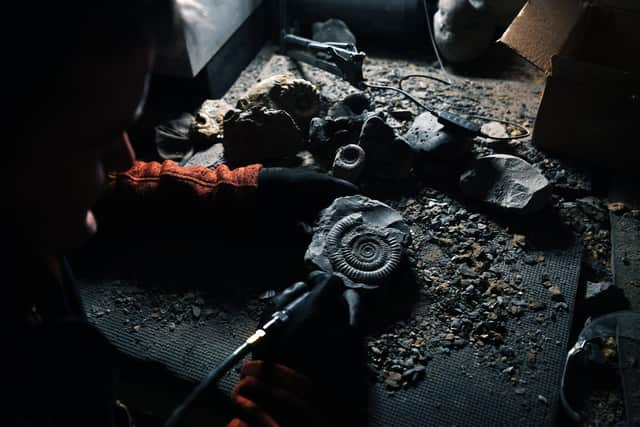Meet the fossil hunter collecting fascinating relics on Yorkshire's coast
The Yorkshire coast is world famous for its sheer volume of fossils – something that Mark Kemp knows all too well. He spends up to six hours at a time searching for fragments of ancient life and his hobby, which became an obsession, is now his full-time occupation.
He takes home the ammonites and other items found on his searches and then “preps” them – a time-consuming job involving special tools to remove surplus hard stone.
Advertisement
Hide AdAdvertisement
Hide AdThe father of two worked in construction and engineering for most of his career but recently decided to take his love of fossil hunting and preparation to the next level by becoming a full- time preparator and collector.


“There are thousands of types of fossils from all over the world but the most common are probably ammonites, bivalves and belemnites,” he says. “The fossilisation process occurs after an animal has died – the soft parts are decomposed, leaving the hard parts like the shell or skeleton behind. This becomes buried by small particles of rock called sediment. Over many years minerals in the water replace the shell or bone, leaving a rock replica of the original creature that we call fossils.”
Last December, Mark was the focus of media attention after a reptile jawbone was discovered. “The temnodontosaurus partial jaw section was found on the Holderness coast as a glacial erratic by my friend. He didn’t know what it was but I instantly knew the importance. He agreed to let me have it and take it home for preparation.”
Temnodontosaurus was the largest of all ichthyosaurs and grew up to 40 feet long with a skull of up to two metres. One was famously discovered and correctly identified by 12-year-old Mary Anning in Lyme Regis in the early 1800s.
Advertisement
Hide AdAdvertisement
Hide Ad“The teeth in my block are just over 100mm and would have the biting force of 10 modern day crocodiles combined,” says Mark. “They swam the oceans during the Triassic, Jurassic and Cretaceous periods and likely died out at the same time as the dinosaurs 66 million years ago.


“I have made some truly remarkable discoveries over the years now including ammonites in all shapes and sizes, large, small, coiled and uncoiled, some with spines and some with beautiful calcite preservation. Various bone blocks from ichthyosaurs, plesiosaurs, crocodiles and fish. Belemnites, crinoids, starfish and plant life. I even found some dinosaur footprints.”
The preparation process to reveal the true beauty of the fossils is complex and technical – it can be noisy and dusty and take hours to complete. “One fossil took me just over 120 hours to prepare alone,” adds Mark, who uses a variety of tools, including a compressor and a manifold splitter to which his pens and grinder are connected.
The pens remove the matrix and help with fine detailed work, which produces a great deal of dust and flying shards of stone. He takes safety very seriously and always wears a dust mask and eye protection while prepping in the workshop he built during lockdown.


Advertisement
Hide AdAdvertisement
Hide AdHis interest in fossils started from a young age, with history his favourite subject at school. “I actually started metal detecting long before fossil hunting. History has always been fascinating to me, especially natural history. I often put myself back in time when discovering fossils and imagine what the environment was like millions of years ago.
“I absolutely love fossil hunting, it’s so much more than just rocks on the beach. The thrill of the hunt, researching new locations, travelling to new places. Discovering a fossil that has not been seen by any other human ever is pretty impressive and inspiring.
“My wife Joanna wasn’t too convinced at first but she has grown to like my obsession and has been so supportive of my decision to pursue this as a career. Some would say she has been my rock...”
Mark’s children Tommy, four, and Ruby, 11, enjoy seeing what their dad finds and how he prepares the fossils. “Tommy is dinosaur mad so anything with teeth and he’s just super excited, whereas Ruby loves the shiny crystal side of the hobby.”
Advertisement
Hide AdAdvertisement
Hide AdA hammer and chisel are useful when out on the beach, along with eye protection when bashing the rocks. “Our eyes are the biggest tool and generally speaking, kids find more because they are closer to the ground,” says Mark, who hunts all year round on the Holderness coast from Spurn Point to Bridlington.
“This stretch of coastline is known as glacial till where material from the ice age has been deposited from far and wide. Whenever going out collecting, the first thing I check is the tide times and weather. I have heard way too many stories of people just turning up at the beach oblivious of tides and getting in some really dangerous situations which has resulted in the RNLI being called.
"A general rule of thumb is to collect on a falling tide and return to safety before the tide turns. And cliffs can be very unstable so stick to the lower half of the beach. Looking for fossils isn’t a science, once you get your eye in it can be pretty easy and generally speaking if it looks like a fossil, it probably is.
“I go in all weathers, rain, snow or shine. Some people would argue seasons matter but I have had some amazing finds during the summer. During the winter, rough seas and storms will obviously churn up the beach and produce more fossils but it really does depend on a lot of luck and just spending time on the beach. I go three or four times a week most weeks and if I get one decent find a month I’m very happy.”
Advertisement
Hide AdAdvertisement
Hide AdMark recommends the health and wellbeing benefits of fossil hunting. “It is a great escape and I mean that in a very positive sense. In this world we live in with so much bad news, I think it’s great for everyone to be able to do something they truly love and to just turn off and concentrate on something enjoyable.
"When I’m on the beach hunting, my mind is clear and I am 100 per cent focused on searching for fossils. I love the solitude of life on the beach – you get so much more accustomed to the natural noises, colours and wildlife.”
He is often asked where the best place is to find fossils but he says there is no special beach or hidden cove that full-time collectors go to. “Geology just doesn’t work like that. Sure there are different beds and formations which yield different species but generally speaking the vast majority of collectors just want to go out for the day with their wife and kids and find a few ammonites.
“Each location is different in terms of how far you have to walk but there are some great resources online where, with very little effort, you can find out where to go, park, walk and collect.”
Advertisement
Hide AdAdvertisement
Hide AdAs well as displaying his fossils in his “full to the brim” display cabinets at his home in Hull, Mark offers his prepping services to other collectors. He also uploads videos of his hunting trips to his YouTube channel which he launched in the early days of the pandemic.
“I say where I am, where I’m going and show what I find and recently have started showing prepared fossils from my day out collecting. I passed the 1,000 subscriber point a few weeks back and I was so happy.”
To watch Mark’s videos go to www.youtube.com/c/TheYorkshireFossilHunter or Instagram yorkshire_fossil_hunter
Support The Yorkshire Post and become a subscriber today. Your subscription will help us to continue to bring quality news to the people of Yorkshire. In return, you'll see fewer ads on site, get free access to our app and receive exclusive members-only offers. Click here to subscribe.
